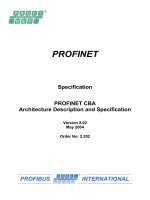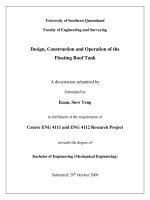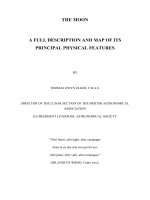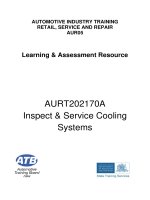Ford training section1 description and operation
Bạn đang xem bản rút gọn của tài liệu. Xem và tải ngay bản đầy đủ của tài liệu tại đây (4.74 MB, 186 trang )
SECTION 1
Description and Operation
Contents
Vehicle Emission Control Information (VECI)..................................1-1
Vehicle Certification Label ...............................................................1-5
Base Engine Calibration Information............................................1-5
Vehicle Emission Control Information (VECI) Acronym
Definitions ....................................................................................1-8
Engine Control Components..........................................................1-10
Accelerator Pedal Position (APP) Sensor..................................1-10
Ambient Air Temperature (AAT) Sensor ....................................1-11
Barometric Pressure (BARO) Sensor ........................................1-12
Brake Pedal Position (BPP) Switch ...........................................1-12
Brake Pressure Switch ...............................................................1-13
Camshaft Position (CMP) Sensor ..............................................1-13
Canister Vent (CV) Solenoid ......................................................1-14
Charge Air Cooler Temperature (CACT) Sensor.......................1-15
Check Fuel Cap Indicator...........................................................1-15
Clutch Pedal Position (CPP) Switch ..........................................1-15
Coil On Plug (COP)....................................................................1-16
2011Powertrain Control/Emissions Diagnosis, 8/2010
SECTION 1
Description and Operation
Contents (Continued)
Coil Pack ....................................................................................1-16
Crankshaft Position (CKP) Sensor.............................................1-18
Cylinder Head Temperature (CHT) Sensor ...............................1-19
Differential Pressure Feedback Exhaust Gas
Recirculation (EGR) Sensor .....................................................1-19
Electric Cooling Fan ...................................................................1-21
Electric Exhaust Gas Recirculation (EEGR) Valve ....................1-22
Electronic Throttle Actuator Control (TAC) ................................1-23
Electronic Throttle Body Throttle Position Sensor
(ETBTPS)..................................................................................1-24
Engine Coolant Temperature (ECT) Sensor..............................1-24
Engine Oil Temperature (EOT) Sensor......................................1-24
Evaporative Emission (EVAP) Canister Purge Valve ................1-25
Evaporative Emission (EVAP) Canister Purge Check
Valve .........................................................................................1-26
Evaporative Emission (EVAP) Natural Vacuum Leak
Detection (NVLD) Module.........................................................1-27
Exhaust Gas Recirculation (EGR) Orifice Tube
Assembly...................................................................................1-28
2011Powertrain Control/Emissions Diagnosis, 8/2010
SECTION 1
Description and Operation
Contents (Continued)
Exhaust Gas Recirculation (EGR) System Module
(ESM) ........................................................................................1-28
Exhaust Gas Recirculation (EGR) Vacuum Regulator
Solenoid ....................................................................................1-29
Exhaust Gas Recirculation (EGR) Valve ...................................1-30
Fan Control .................................................................................1-31
Fan Speed Sensor (FSS)...........................................................1-33
Fuel Injection Pump....................................................................1-33
Fuel Injectors ..............................................................................1-35
Fuel Injectors — Direct Injection ................................................1-35
Fuel Pump (FP) Module .............................................................1-36
Fuel Pump (FP) Module and Reservoir .....................................1-38
Fuel Rail Pressure (FRP) Sensor ..............................................1-38
Fuel Rail Pressure Temperature (FRPT) Sensor ......................1-38
Fuel Tank Pressure (FTP) Sensor .............................................1-39
Heated Oxygen Sensor (HO2S).................................................1-40
Idle Air Control (IAC) Valve........................................................1-41
Inertia Fuel Shut-off (IFS) Switch...............................................1-42
2011Powertrain Control/Emissions Diagnosis, 8/2010
SECTION 1
Description and Operation
Contents (Continued)
Intake Air Temperature (IAT) Sensor.........................................1-42
Intake Manifold Tuning Valve (IMTV).........................................1-44
Knock Sensor (KS).....................................................................1-45
Manifold Absolute Pressure (MAP) Sensor ...............................1-45
Mass Air Flow (MAF) Sensor .....................................................1-46
Output Shaft Speed (OSS) Sensor ............................................1-48
Power Steering Pressure (PSP) Sensor ....................................1-48
Power Steering Pressure (PSP) Switch.....................................1-49
Power Take-Off (PTO) Switch and Circuits ...............................1-49
Throttle Position (TP) Sensor.....................................................1-50
Transmission Control Indicator Lamp (TCIL) .............................1-50
Transmission Control Switch (TCS) ...........................................1-50
Turbocharger ..............................................................................1-51
Turbocharger Boost Pressure (TCBP) Sensor ..........................1-52
Turbocharger Bypass (TCBY) Valve..........................................1-52
Turbocharger (TC) Wastegate Regulating Solenoid
Valve .........................................................................................1-53
Universal Heated Oxygen Sensor (HO2S) ................................1-53
2011Powertrain Control/Emissions Diagnosis, 8/2010
SECTION 1
Description and Operation
Contents (Continued)
Vehicle Speed Sensor (VSS) .....................................................1-54
Engine Control (EC) System..........................................................1-55
Powertrain Control Hardware.........................................................1-57
Powertrain Control Module (PCM) .............................................1-57
PCM Locations ...........................................................................1-57
Fuel Pump Control Module ........................................................1-61
Fuel Pump Driver Module (FPDM).............................................1-62
Keep Alive Memory (KAM).........................................................1-62
Power and Ground Signals ........................................................1-62
Powertrain Control Module - Vehicle Speed Output
(PCM-VSO) ...............................................................................1-64
Powertrain Control Software ..........................................................1-66
Adaptive Airflow ..........................................................................1-66
Check Fuel Cap Indicator...........................................................1-66
Computer Controlled Shutdown .................................................1-66
Deceleration Fuel Shut-Off (DFSO) ...........................................1-66
Engine Fluid Temperature Management....................................1-66
Engine RPM And Vehicle Speed Limiter ...................................1-67
2011Powertrain Control/Emissions Diagnosis, 8/2010
SECTION 1
Description and Operation
Contents (Continued)
Fail-Safe Cooling Strategy .........................................................1-67
Failure Mode Effects Management (FMEM) ..............................1-68
Flash Electrically Erasable Programmable Read Only
Memory (EEPROM) ..................................................................1-68
Fuel Level Input (FLI) .................................................................1-68
Fuel Trim ....................................................................................1-68
High Speed Controller Area Network (CAN) .............................1-69
Idle Air Trim ................................................................................1-69
Idle Speed Control Closed Throttle Determination —
Applications Without Electronic Throttle Control (ETC) ..........1-70
International Standards Organization (ISO) 14229
Diagnostic Trouble Code (DTC) Descriptions ..........................1-70
Multiplexing .................................................................................1-74
Multiplexing Implementation .......................................................1-74
Permanent Diagnostic Trouble Code (DTC) ..............................1-75
Malfunction Indicator Lamp (MIL) ..................................................1-76
Catalyst and Exhaust Systems ......................................................1-77
Evaporative Emission (EVAP) Systems ........................................1-82
Exhaust Gas Recirculation (EGR) Systems ..................................1-85
2011Powertrain Control/Emissions Diagnosis, 8/2010
SECTION 1
Description and Operation
Contents (Continued)
Differential Pressure Feedback Exhaust Gas
Recirculation (EGR) System.....................................................1-85
Electric Exhaust Gas Recirculation (EEGR) System .................1-86
Exhaust Gas Recirculation (EGR) System Module
(ESM) ........................................................................................1-87
Fuel Systems .................................................................................1-90
Electronic Returnless Fuel System (ERFS) ...............................1-90
Fuel Pump Control — ERFS......................................................1-92
Fuel Pump Monitor (FPM) — ERFS ..........................................1-94
Mechanical Returnless Fuel System (MRFS) — Single
Speed........................................................................................1-95
Fuel Pump Control — Single Speed MRFS ..............................1-96
Fuel Pump Monitor (FPM) — Single Speed MRFS...................1-97
Mechanical Returnless Fuel System (MRFS) — Dual
Speed........................................................................................1-97
Fuel Pump Control — Dual Speed MRFS.................................1-99
Fuel Pump Monitor (FPM) — Dual Speed MRFS .....................1-99
High Pressure Fuel System .........................................................1-101
Ignition Systems ...........................................................................1-103
2011Powertrain Control/Emissions Diagnosis, 8/2010
SECTION 1
Description and Operation
Contents (Continued)
Intake Air Systems .......................................................................1-107
Positive Crankcase Ventilation (PCV) System ............................1-115
Supercharger and Charge Air Cooler (CAC) Systems................1-118
Torque Based Electronic Throttle Control (ETC) ........................1-122
Turbocharger and Charge Air Cooler (CAC) Systems................1-128
Variable Camshaft Timing (VCT) System....................................1-132
On Board Diagnostics (OBD) Monitors........................................1-135
OBD I, OBD II and Engine Manufacturer Diagnostics
(EMD) Overview .....................................................................1-135
Air Fuel Ratio Imbalance Monitor ................................................1-139
Catalyst Efficiency Monitor...........................................................1-140
General Catalyst Monitor Operation.........................................1-142
Integrated Air Fuel Catalyst Monitor ........................................1-143
Cold Start Emission Reduction Monitor.......................................1-144
Comprehensive Component Monitor (CCM) ...............................1-148
Electric Exhaust Gas Recirculation (EEGR) System
Monitor .....................................................................................1-150
Enhanced Thermostat Monitor.....................................................1-153
2011Powertrain Control/Emissions Diagnosis, 8/2010
SECTION 1
Description and Operation
Contents (Continued)
Evaporative Emission (EVAP) Leak Check Monitor....................1-154
Engine On EVAP Leak Check Monitor — Fiesta ....................1-154
Engine On EVAP Leak Check Monitor — All Others ..............1-155
Engine Off Natural Vacuum (EONV) EVAP Leak Check
Monitor ....................................................................................1-157
Natural Vacuum Leak Detection (NVLD) Small Leak
Monitor ....................................................................................1-160
Exhaust Gas Recirculation (EGR) System Monitor —
Differential Pressure Feedback EGR and EGR System
Module (ESM)..........................................................................1-162
Fuel System Monitor ....................................................................1-164
Heated Oxygen Sensor (HO2S) Monitor .....................................1-166
Misfire Detection Monitor .............................................................1-168
Positive Crankcase Ventilation (PCV) System Monitor ...............1-174
Thermostat Monitor ......................................................................1-175
Variable Camshaft Timing (VCT) Monitor....................................1-177
2011Powertrain Control/Emissions Diagnosis, 8/2010
Description and Operation
1-1
Table of Contents
Vehicle Emission Control Information (VECI)
VECI Decal
Each vehicle has a VECI decal containing emission control information that applies specifically to
the vehicle and engine. The specifications on the decal are critical to repairing the emissions
systems.
Typical VECI Decal
VECI Decal Location
The decal is typically located on the underside of the hood or on the radiator support sight shield.
Engine/Evaporative Emission (EVAP) System Information
Manufacturers must use a standardized system for identifying their individual engine families. The
system described below was developed by the Environmental Protection Agency (EPA) in 1991 to
meet new regulatory requirements for 1994 and later model years.
The engine family group and evaporative family name consist of 12 characters each.
Both the engine family group and the evaporative family name are listed in the box on the
emission decal in the area marked as engine evaporative family information. The first line contains
engine size and the 12-character engine family group. The second line contains the 12-character
evaporative family name information. Both the engine family group and the evaporative family
name are specific to the vehicle. Refer to the Engine Family Group and the Evaporative Family
Name worksheet for decoding information.
2011Powertrain Control/Emissions Diagnosis, 8/2010
1-2
Description and Operation
Vehicle Emission Control Information (VECI)
Typical VECI Decal
Item
1
Part
Number
—
2
—
3
—
Description
Exhaust Emission Control
System
Engine Evaporative Family
Information
Label Part Number
2011Powertrain Control/Emissions Diagnosis, 8/2010
Description and Operation
1-3
Vehicle Emission Control Information (VECI)
2011Powertrain Control/Emissions Diagnosis, 8/2010
1-4
Description and Operation
Vehicle Emission Control Information (VECI)
2011Powertrain Control/Emissions Diagnosis, 8/2010
Description and Operation
1-5
Vehicle Certification Label
Base Engine Calibration Information
Base engine calibration information, sometimes referred to as the powertrain calibration, is located
in the lower right corner of the vehicle certification label. Engine calibration information is limited to
a maximum of 5 characters per line (2 lines maximum). Calibration information more than 5
characters long wraps to the second line of this field. Only the base calibration appears on this
label. The revision level is no longer printed on the label. However, it can be found in the On-Line
Automotive Service Information System (OASIS). For additional information on the vehicle
certification label or engine calibration, refer to the Workshop Manual Section 100-01, Identification
Codes.
Engine Calibration Information (Car)
Typical Car Vehicle Certification Label
2011Powertrain Control/Emissions Diagnosis, 8/2010
1-6
Description and Operation
Vehicle Certification Label
Engine Calibration Information (Truck)
Typical Truck Vehicle Certification Label
Vehicle Certification Label Location
The vehicle certification label is typically located on the LH door or door post pillar.
Engine Calibration Code
2011 Model Year Example
Engine Calibration Code: BB7 1 4D 0 A 00
B
MODEL YEAR — Model year in which the calibration was first introduced. B equals
2011
B7
VEHICLE CODE — Vehicle line description. B7 equals Expedition
1
TRANSMISSION CODE — Transmission description. 1 equals automatic, 2 equals
manual
4D
UNIQUE CALIBRATION — Identifications are assigned to cover similar vehicles to
differentiate between tires, drive configurations, final drive ratios and other
calibration-significant factors.
0
FLEET CODE — Describes which fleet the vehicle belongs to. 0 equals Certification
(U.S. 4K)
(Continued)
2011Powertrain Control/Emissions Diagnosis, 8/2010
Description and Operation
1-7
Vehicle Certification Label
2011 Model Year Example
Engine Calibration Code: BB7 1 4D 0 A 00
A
CERTIFICATION REGION — Lead region code where multiple regions are included
in one calibration. A equals U.S. Federal
00
REVISION LEVEL — Revision level of the calibration. 00 equals Job 1 production or
initial calibration. (Not printed on vehicle certification label)
2011Powertrain Control/Emissions Diagnosis, 8/2010
1-8
Description and Operation
Vehicle Emission Control Information (VECI) Acronym
Definitions
CAC: Charge Air Cooler
CARB: California Air Resource Board
CARB LEV: Low Emission Vehicle
CARB SULEV: Super Ultra Low Emission Vehicle
CARB TLEV: Transitional Low Emission Vehicle
CARB ULEV: Ultra Low Emission Vehicle
CARB ZEV: Zero Emission Vehicle
CI: Cylinder Injection
DGI: Direct Gas Injection
EPA: Environmental Protection Agency
EVAP: Evaporative Emission
GVW: Gross Vehicle Weight
GVWR: Gross Vehicle Weight Rating, curb weight plus payload.
HHDDE: Heavy Heavy Duty Diesel Engine
HHDE: Heavy Heavy Duty Engine
HO2S: Heated Oxygen Sensor
ILEV: Inherently Low Emission Vehicle
LDDT: Light Duty Diesel Truck categories
LDT: Light Duty Truck (gasoline) categories based on weight as defined in the table.
LDV: Light Duty Vehicle, generally passenger cars and light trucks under 2,721.55 Kg (6,000 lb)
GVWR.
LEV: Low Emission Vehicle
LEV-II: California regulations beginning in the 2004 model year.
LHDE: Light Heavy Duty Engine (several weight categories).
LVW: Loaded Vehicle Weight, curb weight plus 136.08 Kg (300 lb).
MDPV: Medium Duty Passenger Vehicle
MDT: Medium Duty Truck categories based on weight as defined in the table.
MDV: Medium Duty Vehicle
MHDDE: Medium Heavy Duty Diesel Engine
MHDE: Medium Heavy Duty Engine
2011Powertrain Control/Emissions Diagnosis, 8/2010
Description and Operation
1-9
Vehicle Emission Control Information (VECI) Acronym
Definitions
MPI: Multi-Port Injection
MY: Model Year
NCP: Non-Compliance Penalty
OBD: On Board Diagnostics
ORVR: On Board Refueling Vapor Recovery
PC: Passenger Car
PZEV: Partial Zero Emission Vehicle
SFI: Sequential Multiport Fuel Injection
SI: Sequential Injection
SULEV: Super Ultra Low Emission Vehicle
TC: Turbocharged
Tier 0: California and Federal regulations effective prior to Tier 1 phase in dates.
Tier 1: California regulations beginning in 1993 model year and Federal regulations beginning in
1994 model year.
Tier 2: Federal regulations beginning in the 2004 model year.
TWC: Three-Way Catalytic Converter
ULEV: Ultra Low Emission Vehicle
ZEV: Zero Emission Vehicle
2011Powertrain Control/Emissions Diagnosis, 8/2010
1-10
Description and Operation
Engine Control Components
Note: Transmission inputs which are not described in this section are discussed in the applicable
Workshop Manual transmission section.
Accelerator Pedal Position (APP) Sensor
The APP sensor is an input to the powertrain control module (PCM) and used to determine the
amount of torque requested by the operator. Depending on the application, either a 2 track or 3
track APP sensor is used.
2 Track APP Sensor — Fiesta
There are 2 separate pedal position sensors in the accelerator pedal. The APP1 sensor signal
generates a pulse width modulated signal to the PCM. The APP1 sensor uses a VPWR circuit, a
ground circuit and a signal circuit. Only the APP1 signal circuit is connected to the PCM. The
APP2 sensor signal has a positive slope (increasing angle, increasing voltage) and is a class 2
message from the instrument panel cluster (IPC) to the PCM. The APP2 sensor uses a reference
voltage circuit, a signal return circuit, and a signal circuit between the IPC and the APP sensor
assembly. The two pedal position signals make sure the PCM receives a correct input even if one
of the signals has a concern. The PCM determines if a signal is incorrect by calculating an
expected position, inferred from the other signals. If a concern is present with one of the circuits
the other input is used. The pedal position signal is converted to pedal travel degrees (rotary
angle) by the PCM. The software converts these degrees to counts, which is the input to the
torque based strategy. For additional information, refer to Torque-Based Electronic Throttle Control
(ETC) in this section.
2 Track APP Sensor — All Others
There are 2 pedal position signals in the sensor. Both signals, APP and APP2, have a positive
slope (increasing angle, increasing voltage), but are offset and increase at different rates. The 2
pedal position signals make sure the PCM receives a correct input even if 1 signal has a concern.
The PCM determines if a signal is incorrect by calculating where it should be, inferred from the
other signals. If a concern is present with one of the circuits the other input is used. There are 2
reference voltage circuits, 2 signal return circuits, and 2 signal circuits (a total of 6 circuits and
pins) between the PCM and the APP sensor assembly. The pedal position signal is converted to
pedal travel degrees (rotary angle) by the PCM. The software converts these degrees to counts,
which is the input to the torque based strategy. For additional information, refer to Torque-Based
Electronic Throttle Control (ETC) in this section.
2011Powertrain Control/Emissions Diagnosis, 8/2010
Description and Operation
1-11
Engine Control Components
Typical 2 Track APP Sensor
3 Track APP Sensor
There are 3 pedal position signals in the sensor. Signal 1, APP, has a negative slope (increasing
angle, decreasing voltage) and signals 2 and 3, APP2 and APP3, both have a positive slope
(increasing angle, increasing voltage). During normal operation, APP is used as the indication of
pedal position by the strategy. The 3 pedal position signals make sure the PCM receives a correct
input even if one signal has a concern. The PCM determines if a signal is incorrect by calculating
where it should be, inferred from the other signals. If a concern is present with one of the circuits
the other inputs are used. The pedal position signal is converted to pedal travel degrees (rotary
angle) by the PCM. The software converts these degrees to counts, which is the input to the
torque based strategy. There are 2 reference voltage circuits, 2 signal return circuits, and 3 signal
circuits (a total of 7 circuits and pins) between the PCM and the APP sensor assembly.
Typical 3 Track APP Sensor
Ambient Air Temperature (AAT) Sensor
The AAT sensor is a thermistor device in which resistance changes with temperature. The
electrical resistance of a thermistor decreases as the temperature increases, and the resistance
increases as the temperature decreases. The varying resistance affects the voltage drop across
the sensor terminals and provides electrical signals to the PCM corresponding to temperature.
2011Powertrain Control/Emissions Diagnosis, 8/2010
1-12
Description and Operation
Engine Control Components
Thermistor-type sensors are considered passive sensors. A passive sensor is connected to a
voltage divider network so that varying the resistance of the passive sensor causes a variation in
total current flow. Voltage that is dropped across a fixed resistor in a series with the sensor
resistor determines the voltage signal at the PCM. This voltage signal is equal to the reference
voltage minus the voltage drop across the fixed resistor.
The AAT sensor provides ambient air temperature information to the PCM for the temperature
sensor correlation tests. The PCM also communicates the AAT sensor information to all other
modules on the controller area network (CAN).
Typical AAT Sensor
Barometric Pressure (BARO) Sensor
The BARO sensor directly measures barometric pressure to estimate the exhaust back pressure.
Exhaust back pressure influences speed density based air charge computation. The BARO sensor
is mounted directly to the PCM circuit board.
Brake Pedal Position (BPP) Switch
The BPP switch is sometimes referred to as the stoplamp switch. The BPP switch provides a
signal to the PCM indicating the brakes are applied. The BPP switch is normally open and
mounted on the brake pedal support. Depending on the vehicle application the BPP switch can be
hardwired as follows:
• to the PCM supplying battery positive (B+) voltage when the brake pedal is applied.
• to the anti-lock brake system (ABS) module, or lighting control module (LCM), the BPP signal is
then broadcast over the network to be received by the PCM.
• to the ABS traction control/stability assist module. The ABS module interprets the BPP switch
input along with other ABS inputs and generates an output called the driver brake application
(DBA) signal. The DBA signal is then sent to the PCM and to other BPP signal users.
2011Powertrain Control/Emissions Diagnosis, 8/2010
Description and Operation
1-13
Engine Control Components
Typical BPP Switch
Brake Pressure Switch
The brake pressure switch is used for vehicle speed control deactivation. A normally closed switch
supplies battery positive (B+) voltage to the PCM when the brake pedal is not applied. When the
brake pedal is applied, the normally closed switch opens and power is removed from the PCM.
On some applications the normally closed brake pressure switch, along with the normally open
BPP switch, are used for a brake rationality test within the PCM. The PCM misfire monitor profile
learn function may be disabled if a brake switch concern occurs. If one or both brake pedal inputs
to the PCM is not changing states as expected, a diagnostic trouble code (DTC) is set by the PCM
strategy.
Camshaft Position (CMP) Sensor
The CMP sensor detects the position of the camshaft. The CMP sensor identifies when piston
number 1 is on its compression stroke. A signal is then sent to the PCM and used for
synchronizing the sequential firing of the fuel injectors. Coil on plug (COP) ignition applications use
the CMP signal to select the correct ignition coil to fire.
Engines with 2 camshafts and with variable camshaft timing (VCT) are equipped with 2 CMP
sensors. The second sensor is used to identify the position of the camshaft on bank 2. Engines
with 4 camshafts and with variable camshaft timing (VCT) are equipped with 4 CMP sensors. The
4 sensors are used to identify the position of each camshaft.
The 4 sensor system uses the following CMP signal circuit names:
• CMP11 - bank 1, intake camshaft
• CMP12 - bank 1, exhaust camshaft
• CMP21 - bank 2, intake camshaft
• CMP22 - bank 2, exhaust camshaft
2011Powertrain Control/Emissions Diagnosis, 8/2010
1-14
Description and Operation
Engine Control Components
The 2 pin variable reluctance sensor and the 3 pin hall effect sensor are the 2 types of CMP
sensors used.
Typical Variable Reluctance CMP Sensor
Typical Hall Effect CMP Sensor
Canister Vent (CV) Solenoid
During the evaporative emissions (EVAP) leak check monitor, the CV solenoid seals the EVAP
canister from the atmospheric pressure. This allows the EVAP canister purge valve to obtain the
target vacuum in the fuel tank during the EVAP leak check monitor.
Typical Canister Vent (CV) Solenoid
2011Powertrain Control/Emissions Diagnosis, 8/2010
Description and Operation
1-15
Engine Control Components
Charge Air Cooler Temperature (CACT) Sensor
The CACT sensor is located in the intake air tube between the charge air cooler (CAC) and the
throttle body. The CACT sensor measures the throttle inlet temperature. The PCM uses the CACT
sensor information to refine the estimate of the air flow rate through the throttle and to determine
the desired boost pressure. The CACT sensor for a speed density system is integrated with the
turbocharger boost pressure (TCBP) sensor.
Typical CACT Sensor Integrated With a
TCBP Sensor
Check Fuel Cap Indicator
The check fuel cap indicator is a communications network message sent by the PCM. The PCM
sends the message to illuminate the lamp when the strategy determines there is a concern in the
EVAP system due to the fuel filler cap or capless fuel tank filler pipe not being sealed correctly.
This is detected by the inability to pull vacuum in the fuel tank after a fueling event.
Clutch Pedal Position (CPP) Switch
The CPP switch is an input to the PCM indicating the clutch pedal position. The PCM provides a
low current voltage on the CPP circuit. When the CPP switch is closed, this voltage is pulled low
through the signal return (SIG RTN) circuit. The CPP input to the PCM is used to detect a
reduction in engine load. The PCM uses the load information for mass air flow and fuel
calculations.
2011Powertrain Control/Emissions Diagnosis, 8/2010
1-16
Description and Operation
Engine Control Components
Typical Clutch Pedal Position (CPP)
Switch
Coil On Plug (COP)
The COP ignition operates similar to a standard coil pack ignition except each plug has 1 coil per
plug. The COP operates in engine crank, engine running and camshaft position failure mode
effects management (FMEM) modes. For additional information, refer to Ignition Systems in this
section.
Typical Coil On Plug (COP)
Coil Pack
The PCM provides a grounding switch for the coil primary circuit. When the switch is closed,
voltage is applied to the coil primary circuit. This creates a magnetic field around the primary coil.
The PCM opens the switch, causing the magnetic field to collapse, inducing the high voltage in the
secondary coil windings and firing the spark plug. The spark plugs are paired so that as 1 spark
plug fires on the compression stroke, the other spark plug fires on the exhaust stroke. The next
time the coil is fired the order is reversed. The next pair of spark plugs fire according to the engine
firing order.
2011Powertrain Control/Emissions Diagnosis, 8/2010









